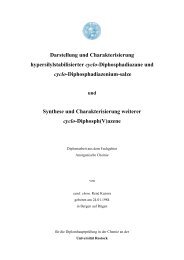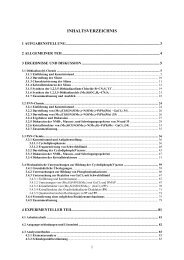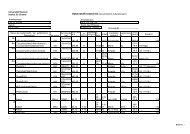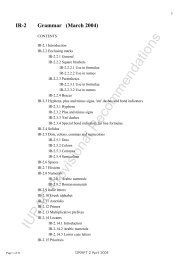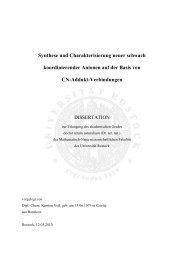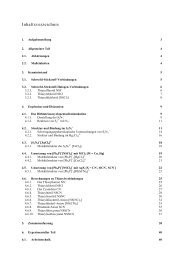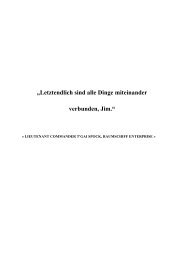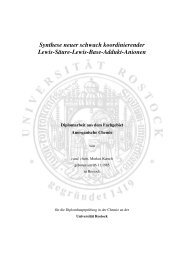Darstellung und Charakterisierung neuer niedrigkoordinierter ...
Darstellung und Charakterisierung neuer niedrigkoordinierter ...
Darstellung und Charakterisierung neuer niedrigkoordinierter ...
Create successful ePaper yourself
Turn your PDF publications into a flip-book with our unique Google optimized e-Paper software.
exchange occurs in the cation (reaction time 16 h), resulting in<br />
mixed crystals with about ¾ Cl and ¼ N3 attached to the As2N2<br />
ring. Only when a large excess of Me 3SiN 3 is used and the<br />
reaction time is increased (2 days instead of 2 hours) a complete<br />
chloride-azide exchange is observed and pure 3 is formed (Figure<br />
3). Azide formation in the anion and/or cation can also easily be<br />
observed by means of IR spectroscopy (anion: ν as(N 3) = 2157,<br />
cation: 2102 cm –1 ).<br />
Crystals of 1,3-diarsa-2,4-diazenium salts 2-5 are black,<br />
moisture sensitive but stable <strong>und</strong>er argon atmosphere over a long<br />
period as solid and in CH2Cl2 at ambient temperature. The black<br />
appearance vanishes rapidly when traces of H 2O are present. All<br />
salts 2-5 are easily prepared in bulk and are infinitely stable when<br />
stored in a sealed tube and kept cool at –20 °C in the dark. Albeit<br />
salts 3-5 are covalently bo<strong>und</strong> azides, they are neither heat nor<br />
shock sensitive. Decomposition starts above 142 °C in 3 and 179<br />
°C in 5 (cf. 2: decomposition T > 199 °C), respectively.<br />
Figure 2. ORTEP drawing of the molecular structure of 3 in the crystal.<br />
Thermal ellipsoids with 50% probability at 173 K (hydrogen atoms omitted<br />
for clarity). Selected bond lengths (Å) and angles (°): As1–N1<br />
1.799(3), As1–N2 1.812(2), As2–N1 1.901(3), As2–N2 1.915(3), As2–<br />
N3 1.938(3), N3–N4 1.216(4), N4–N5 1.131(4), Ga2–N6 1.978(3), Ga2–<br />
Cl4 2.140(1), N6–N7 1.252(4), N7–N8 1.126(4), N1–As1–N2 82.1(1),<br />
N1–As2–N2 76.8(1), N1–As2–N3 92.2(1), N2–As2–N3 101.0 (1), As1–<br />
N1–As2 100.7 (1), As1–N2–As2 99.7(1), N5–N4–N3 171.5(4), Ga1–<br />
N6–Ga2 125.4(1), N8–N7–N6 178.8(3)<br />
X-ray elucidation of 2 and crystals from the reaction sequences<br />
as illustrated in Scheme 2 (3, 4, and 5, see supporting<br />
information) revealed novel 1,3-diarsa-2,4-diazenium salts with<br />
no significant cation-anion contacts and a di-coordinated As(III)<br />
atom as part of a As 2N 2 ring, kinetically protected in the pocket<br />
formed by the terphenyl groups (Figures 1 and 2). All salts 2-5<br />
crystallize isotypically in black blocks in the monoclinic space<br />
group P21/c with four units per cell. In case of the azide-containing<br />
salts 3, 4 and 5 the cell parameters are almost identical (axes:<br />
deviation < 0.2 Å; angles: deviation < 0.4 °), which is the reason<br />
for the observed formation of mixed crystals in 4 (with ¾ Cl and<br />
¼ N3 attached to the As2N2 ring, see supporting information). As<br />
depicted in Figures 1 and 2, the P 2N 2 rings are almost planar<br />
(deviation from planarity:



